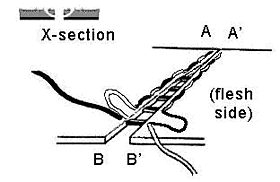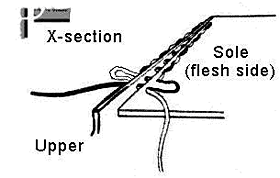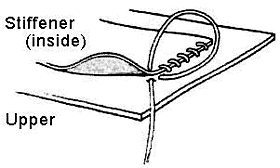12th Century Turn Shoes: A Brief History and Construction
By Countess Comyn Hrothwyn (Ellen Bartel)
Part 1
Introduction
This article will give the reader a brief overview of 12th Century shoe construction and history. The turn shoe pattern selected was worn mostly by upper class English, French, and Germans but has the bonus of being deceptively simple to create for the novice leatherworker. This article assumes a basic level of skill with common leatherworking tools such as an awl, needle, and thread.
Background Overview
“Turn shoe” describes a shoe sewn together while inside out. When completed, the shoe is literally “turned” to place the outside seams inside of the shoe prior to wearing. They are similar to a soft leather moccasin – type slipper without the hard sole or arch support of modern footwear. Styles have been excavated that were both below the ankle and slightly above with a rounded or pointed toe. They were speculated to have been sewn with wax coated plaited linen thread using a boar-bristle as a needle. Due to decay no extant thread examples have been found. Vegetable tanned cattle, sheep or goat leather dyed with an iron oxide based liquid was the preferred medium. Decoration was in various ways, such as embroidery, cut-outs, or skiving (removing the very top layer of leather to leave the rough part exposed).
Pattern and Construction Background
This pattern will be fairly simple for time and skill constraints. It consists of three major pieces – the sole, the vamp and the back quarter, which are sewn together to comprise the major parts of the shoe. Historically the vamp and quarter were joined into one upper piece. Other additional minor pieces adapt the fit of the shoe and add stability.
- Sole – In the early 12th century most soles were an elliptical shape with rounded toe area, not imitating an exact foot shape. There's a slight indentation along the middle of the foot corresponding to the arch area. More foot shaped soles and slightly pointed tips grew more popular towards the century's end. Soles were normally made of 8 oz cattle leather, for durability, flesh side up towards the foot bed.
- Upper (Vamp and Back Quarter) – By the 12th Century, patterns had evolved for uppers consolidating into a single piece. This practice made practical use of leather with little waste, placed a solitary seam inside the area of the foot's arch and produced a better fit. The upper did not fit snugly around the shoe's throat and was generally reinforced with a cord or a top band. It could be laced along the inside seam or the top of the instep for a better fit. Our pattern will consist of two pieces for ease of construction but can easily adapt later to a more historically correct form.
- Additional Pieces (Heel stiffener and Clumps) – Small leather stiffeners were sewn into the heel area to reinforce it, emulating the triangular sole backs of the earlier Viking shoe. 12th century heel stiffeners were triangular or semi circular sewn with a binding stitch separately into place without breaking through the outside surface of the shoe. “Clumps” were additional soles that were tunnel stitched onto the existing sole after it wore through to extend the lifespan of the shoe.
- Seams – Three main types were consistently used in 12th Century shoe construction. Stitch images are borrowed from Shoe from Parliament St., York Construction Notes by Peter Beatson.
- Butt Stitch – used commonly on uppers to sew main side seam and attach inserts.

- Flesh-edge Stitch – used to attach soles to uppers.

- Binding stitch – used to attach pieces such as heel stiffeners, upper edge reinforcement cords, or top bands (sewn to the top edge of the shoe instead of reinforcement cords). The stitch doesn't penetrate the leather completely, therefore is invisible from the outside.

- Butt Stitch – used commonly on uppers to sew main side seam and attach inserts.

